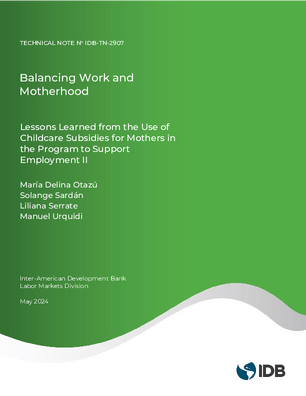Balancing Work and Motherhood: Lessons Learned from the use of Childcare Subsidies for Mothers in the Program to Support Employment
Date
Apr 2024
This document details the experiences of mothers who were beneficiaries of the childcare subsidy for children under 5 years old, provided by the Program to Support Employment II (PAE II), as a supplementary aid to facilitate the labor market insertion of women receiving economic support for on-the-job training. PAE II, implemented by the Public Employment Service of Bolivia under the Ministerio de Trabajo, Empleo y Previsión Social (MTEPS), aimed to enhance the insertion into quality employment of job seekers through job placement support, wage subsidies for up to three months to promote labor insertion associated with on-the-job training. Additionally, PAE II envisaged support for mothers of children under 5 years old, consisting of an additional payment per child disbursed before the start of the on-the-job training. This support was designed to mitigate the risk of mothers withdrawing from the program due to childcare responsibilities. It was presumed that this cost could be covered from the second month onwards with the main payment of the economic support received. The document presents both a quantitative and qualitative analysis of this experience. The first part provides the quantitative analysis using descriptive statistics based on a survey of 71% of the beneficiaries. The second part complements this analysis with qualitative data derived from interviews and direct testimonies from both the beneficiaries and the operational staff of PAE II. The analysis revealed that the subsidy helped families address the challenges associated with entering the labor market, particularly for those without a partner. The support facilitated access to employment opportunities by providing a minimum level of economic stability, allowing them to focus on work without immediate concerns about childcare and the sustenance of their children. The unintended flexibility in the utilization of the subsidy allowed mothers to adapt the support according to their individual needs, whether for childcare, family nourishment, or covering other essential expenses. This necessitates an analysis of whether the payment scheme at the end of the first month affects program participation of economically disadvantaged groups in a context like Bolivia where securing salaried employment, represents an additional challenge.
NO




